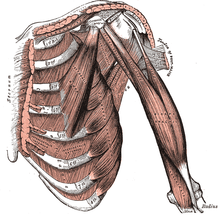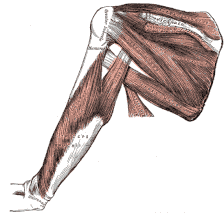COMMON SHOULDER PROBLEMS
WHAT TO DO ABOUT THEM
In the picture below and left, you will notice that the “socket” made by the collar bone (clavicle) and shoulder blade (scapula) is not very deep. The head of the humerus (the “ball”) is held in place by lots of ligaments. These ligaments make up what is referred to as the “Shoulder Capsule”. An intact Shoulder Capsule keeps the lubricating fluid around the joint. And as many of you already know, all of the nerves from the lower neck run through the shoulder area, through the arm, and down to the hand. Because of this, neck problems have the ability to closely mimic certain shoulder problems (RADICULOPATHY and TOS are a couple that come immediately to mind).
The second thing that makes shoulder problems common is the incredible numbers of LIGAMENTS, TENDONS, and MUSCLES that cross the shoulder joint. Some of these include the four Rotator Cuff muscles, the deltoids, the biceps, the triceps, the trapezius, the pectorals, as well as many of the neck muscles. In other words, shoulder problems are often the result of problems in tissues that you may not always associate with your shoulder.
Amazingly, he found that 90% of these “healthy” big league pitchers had cartilage problems and Rotator Cuff tendon issues that showed up on MRI. He concluded the study by making a shocking observation (I am quoting loosley here) —– the only excuse a doctor really needs to operate on a shoulder is an MRI. And interestingly enough, the scientific medical literature bears out what he is saying. In fact, there are a number of studies saying that it is almost impossible to correlate many of the most commonly seen MRI shoulder findings with how much or how little pain / shoulder dysfunction a person is dealing with (HERE are some posts on the limitations of advanced diagnostic imaging). This is probably why we have been able to help lots of people with “torn” Rotator Cuffs — as well as more than a few people who had already been through Rotator Cuff Surgery (this one four decades previous to treatment — HERE).
WHAT ARE SOME OF THE SHOULDER PROBLEMS THAT I CAN OFTEN HELP?
Rotator Cuff tears are something that I can often help. This is because in so many cases, the tears are incidental findings. In other words, just like many cases of HERNIATED SPINAL DISCS, even though there is a Rotator Cuff tear that is present on the MRI, it may have nothing whatsoever to do with a person’s pain. Because 50-70% of the adult American population has asymptomatic Disc Herniations in their low back (Disc Herniations that no not cause pain), many people who have lumbar spine MRI’s are erroneously told that this is the cause of their pain. The problem is that study after study after study says that there is little correlation to MRI findings and low back pain. Unfortunately, the same thing is true with the shoulder.
Just like we saw earlier in Dr. Andrews’ informal study, it is extremely common for shoulder “findings” to show up on an MRI. Be warned. These MRI findings may have nothing whatsoever to do with your pain. This is probably one of the biggest reasons that SPINAL SURGERY and Shoulder Surgery both seem to be a crap shoot. Some people do great with the surgeries. Many do not. In virtually all cases of shoulder surgery, the rehab and recovery is long and painful. What do I tell people about our Scar Tissue Remodeling treatment and Rotator Cuff problems? Although it is unlikely that a single treatment is going to completely resolve the problem, you will know after a single treatment if it is going to help or not.
COMMON SHOULDER PROBLEMS
The three most common shoulder problems I deal with are……..
- FASCIAL ADHESIONS
- TENDINOSIS
- BURSITIS
I cannot even begin to tell you how many shoulder problems that I see on a day-to-day basis are caused by FASCIAL ADHESIONS and / or TENDINOSIS. And interestingly enough, not only has most of the general population never heard of these two common problems, hardly anyone within the Medical Profession seems to be aware of them either — especially the former. This is because microscopic injury and scarring of the Fascia does not ever show up on an MRI. And Tendinosis shows up so rarely we may as well use the word, “never“. It’s like I’ve said before. Out of sight; out of mind.
I have written about both of these topics extensively. Just click on the links above to read them. You may learn something you weren’t aware of —- like the fact that the medical “powers-that-be” declared over two decades ago that there is no such thing as tendinitis —- it does not even exist! And as for BURSITIS; it exists alright. But is is so over-diagnosed / misdiagnosed that you would think it were a common problem. Again, click on the link and start reading.
If you are wondering if your shoulder problem might be helped by what I do here in my clinic, just call us at (417) 934-6337. We are in Mountain View, Missouri about a half hour drive from West Plains. We are centrally located about an hour and a half drive from Springfield, Poplar Bluff, Rolla, and Mountain Home, Arkansas. For those of you traveling to see us, our contact information can be found HERE.



